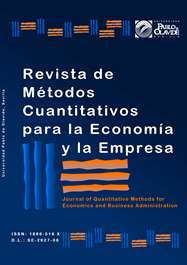Plan maestro de producción basado en programación lineal entera para una empresa de productos químicos
DOI:
https://doi.org/10.46661/revmetodoscuanteconempresa.2885Palabras clave:
planificación de la producción, plan maestro de producción (PMP), programación lineal entera, industria química, production planning, master production scheduling (MPS), integer linear programming, chemical industryResumen
En este trabajo se propone un modelo de programación lineal entera para planificar la producción de un conjunto de artículos finales con demanda independiente. El modelo para la planificación maestra de producción (PMP) está diseñado considerando los costes de producción e inventario, así como las restricciones definidas por el mismo proceso productivo en cuanto a instalaciones y tiempos de producción. El objetivo del modelo propuesto es la minimización de los costes implicados; concretamente, el tiempo ocioso y extra de los recursos, así como la consideración de un nivel mínimo de servicio ligado a la demanda diferida. La validación del modelo considera datos pertenecientes a la demanda de cada producto en un horizonte de 12 semanas y compara cinco escenarios en los que se modifican algunos aspectos del sistema y diferentes niveles de servicio. Por último, los resultados obtenidos para cada uno de los escenarios exponen la mejora obtenida por el modelo propuesto respecto al procedimiento actual en la empresa objeto de estudio.
Descargas
Citas
Boiteux, O.D.; Corominas, A. y Lusa, A. (2007): “Estado del arte sobre planificación agregada de la producción”. Enginyeria d’Organització i Logística Industrial, 4(2), 1–39.
Brandenburg, M. y Tölle, F.J. (2009): “MILP-based campaign scheduling in a speciality chemicals plant: a case study”. OR Spectrum, 31, 141–166.
Buschkühl, L.; Sahling, F.; Helber, S. y Tempelmeier, H. (2010): “Dynamic capacitated lot-sizing problems: A classification and review of solution approaches”. OR Spectrum, 32, 231–261.
Díaz-Madroñero, M.; Mula, J. y Peidro, D. (2014): “A review of discrete-time optimization models for tactical production planning”. International Journal of Production Research, 52(17), 5171–5205.
Dzielinski, B.P. y Gomory, R.E. (1965): “Optimal programming of lot sizes, inventory and labor allocations”. Management Science, 11(9), 874–890.
Escobar, P.; Giraldo, J.A. y Cárdenas, D.M. (2012): “Programación de sistemas de producción híbridos, para inventario/bajo pedido, mediante un proceso analítico jerárquico de ordenación grupal (GAHPO) ”. Información Tecnológica, 23(5), 33–46.
Flores, B.E. y Whybark, D.C. (1986): “Multiple criteria ABC analysis”. International Journal of Operations and Production Management, 6(3), 38–46.
Grunow, M.; Günther, H. O. y Lehmann, M. (2002): “Campaign planning for multi-stage batch processes in the chemical industry”. OR Spectrum, 24, 281–314.
Hax, A.C. y Meal, H.C. (1975): “Hierarchical integration of production planning and scheduling”. En M.A. Geisler (ed.): TIMS Studies in Management Sciences, Volume 1: Logistics. Nueva York: North Holland/American Elsevier, pp. 53–69.
Lasdon, L.S. y Terjung, R.C. (1971): “An efficient algorithm for multi-item scheduling”. Operations Research, 19, 946–969.
Mangiameli, P.M. (1979): The effects of managerial policies on aggregate plans, the master production schedule, and departmental plans. Tesis doctoral, Ohio: Ohio State University.
Moniz, S.; Barbosa-Póvoa, A.P. y de Sousa, J.P. (2014): “Simultaneous regular and non-regular production scheduling of multipurpose batch plants: A real chemical-pharmaceutical case study”. Computers and Chemical Engineering, 67, 83–102.
Mula, J.; Lyons, A.C.; Hernández, J.E. y Poler, R. (2014): “An integer linear programming model to support customer-driven material planning in synchronised, multi-tier supply chains”. International Journal of Production Research, 52(14), 4267–4278.
Mula, J.; Poler, R. y García, J.P. (2006a): “MRP with flexible constraints: A fuzzy mathematical programming approach”. Fuzzy Sets and Systems, 157(1), 74–97.
Mula, J.; Poler, R.; García-Sabater, G.S. y Lario, F.C. (2006b): “Models for production planning under uncertainty: A review”. International Journal of Production Economics, 103(1), 271–285.
Osorio, J.C. y Motoa, T.G. (2008): “Planificación jerárquica de la producción en un job shop flexible”. Revista Facultad de Ingeniería Universidad de Antioquía, 44, 158–171.
Portela, R.V. (2007): “La planeación y programación de la producción en la pyme”. AVANCES. Investigación en Ingenieria, 6(6), 40–57.
Quadt, D. y Kuhn, H. (2008): “Capacitated lot-sizing with extensions: A review”. 4OR, 6(1), 61–83.
Till, J.; Sand, G.; Urselmann, M. y Engell, S. (2007): “A hybrid evolutionary algorithm for solving two-stage stochastic integer programs in chemical batch scheduling”. Computers and Chemical Engineering, 31(5-6), 630–647.
Ul Hassan, M. y Stockhammar, P. (2016): “Fitting probability distributions to economic growth: a maximum likelihood approach”. Journal of Applied Statistics, 43(9), 1583–1603.
Venkataraman, R. y Nathan, J. (1994): “Master Production Scheduling for a Process Industry Environment: A Case Study”. International Journal of Operations and Production Management, 14(10), 44–53.
Descargas
Publicado
Cómo citar
Número
Sección
Licencia
Derechos de autor 2017 Revista de Métodos Cuantitativos para la Economía y la Empresa

Esta obra está bajo una licencia internacional Creative Commons Atribución-CompartirIgual 4.0.
El envío de un manuscrito a la Revista supone que el trabajo no ha sido publicado anteriormente (excepto en la forma de un abstract o como parte de una tesis), que no está bajo consideración para su publicación en ninguna otra revista o editorial y que, en caso de aceptación, los autores están conforme con la transferencia automática del copyright a la Revista para su publicación y difusión. Los autores retendrán los derechos de autor para usar y compartir su artículo con un uso personal, institucional o con fines docentes; igualmente retiene los derechos de patente, de marca registrada (en caso de que sean aplicables) o derechos morales de autor (incluyendo los datos de investigación).
Los artículos publicados en la Revista están sujetos a la licencia Creative Commons CC-BY-SA de tipo Reconocimiento-CompartirIgual. Se permite el uso comercial de la obra, reconociendo su autoría, y de las posibles obras derivadas, la distribución de las cuales se debe hacer con una licencia igual a la que regula la obra original.
Hasta el volumen 21 se ha estado empleando la versión de licencia CC-BY-SA 3.0 ES y se ha comenzado a usar la versión CC-BY-SA 4.0 desde el volumen 22.










